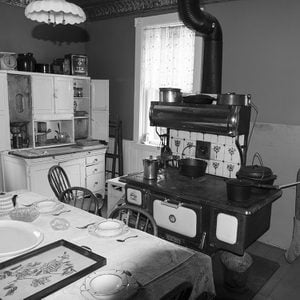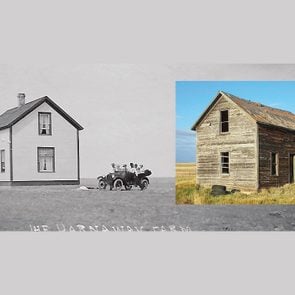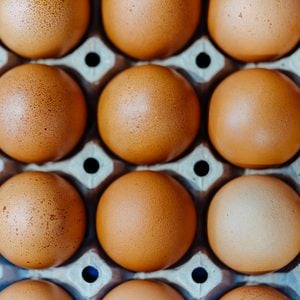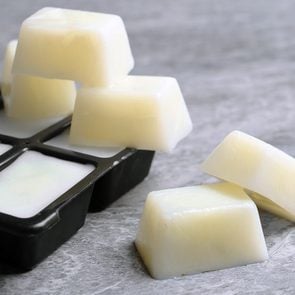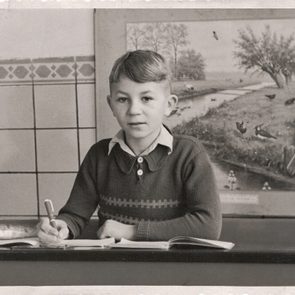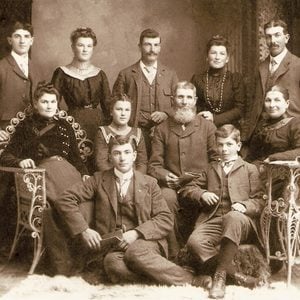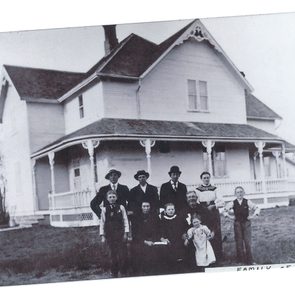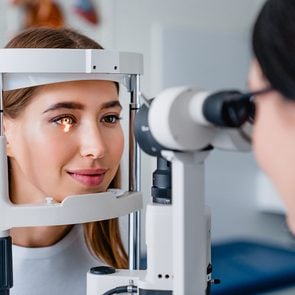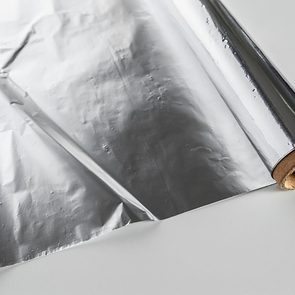
I was born and raised on the family farm near Monarch, Alberta. The first memories I have are of running around the huge living room of our “old house” as my brother Kelsey and I called it. My oma and opa (grandparents) lived across the yard in a newer home. I never really knew the significance of the home we grew up in until I was in my teens.
My parents told Kelsey and me that our home had originally been purchased by the previous owner of our farm, Mr. William J. Van Lohuizen, through the Eaton’s catalogue in 1918. It was listed as Modern Home no. 666 and cost $1,315.50; he paid an extra $14.35 for two extra doors and five windows, bringing the total price to $1,329.85. Lumber was ordered from British Columbia and the millwork done in Winnipeg. The home was not prefabricated, nor was the wood pre-cut. The Eaton’s home was shipped via rail to Monarch, where it was loaded onto a horse and buggy and brought two miles north to the Van Lohuizen farm.

This particular modern home was a five-bedroom, two-pantry model (one pantry on the main floor and one upstairs) with a coal furnace and an outhouse. By 1953, the coal furnace was changed to gas.
In 1959, the farm was bought by my great-grandparents Gerrit and Gezina Bolink from Mr. Van Lohuizen. Ever since then, it has stayed in the Bolink family, passed down through the generations.
In 1997, my parents Chris and Kathleen, Kelsey and I moved into the big “old house” and lived there until 2007. At that point, Oma and Opa moved from their “new“ home on the farm to Nobleford, Alberta, and we moved into their home.

From then on, the old house sat empty, becoming a storage area for old furniture and various items we collected for when Kelsey and I would eventually move out. Kelsey even turned the kitchen into a motorcycle repair shop for a while, and used a space heater in the winter to get his work done.
One summer, following a heavy rain, the basement filled with water. My dad tried to dig a hole in the dirt floor for a sump pump to sit in. It seemed, however, that he kept hitting something very hard. Upon further investigation, it appeared that he was hitting the big beams that supported a battery table; before the house had electricity, a windmill in the yard powered batteries that sat on a large, heavy table in the basement. When the wind howled, we could sometimes feel the house rock back and forth. If you looked in the corner of the rooms afterwards, there were tiny piles of sawdust insulation falling from the walls.

The old house has been up for sale for many years. There has been interest from a few families at various times, but moving costs didn’t make the home worth relocating. My parents wanted to donate the home to the Prairie Tractor and Engine Museum in Picture Butte, Alberta, but they turned down the offer as they had other projects on the go at the time.
Last year, my parents were approached by the Great Canadian Plains Railway Society near Stirling, Alberta, about moving the house and making it an addition to their property. Plans are currently in the works to obtain the necessary grants, as well as to line up the proper channels to move the home in the future, if all goes well. The society hopes to fully restore the house into a liveable state to be used as a groundskeeper’s house.
The old house recently turned 100 years old. It isn’t what it used to be in its glory days, but it’s an honour to say that this house was once my home. It will always hold the best of my childhood memories.
Next, read the heartwarming story of how Andy’s Chinese food became the best in east central Alberta.

Breakthroughs in Stem Cell Therapy For Back Pain
Annissa Jobb had been working as a personal support worker in Toronto for a couple years when her back pain first appeared. The cause: an undiagnosed herniated disc, which had pinched the nerve. As the pain worsened, she gritted her teeth and tried to keep going.
“It was my calling in life, taking care of people,” explains Jobb, now 54. But working with frail seniors involves a lot of lifting, bending and pulling. “I had a drawer full of pain medication. None of it was working. I’d snap. My husband and I came close to getting divorced.”
By November 2016, about a decade after she first noticed the pain, Jobb could scarcely walk 200 metres. “My family doctor finally said, ‘You will end up in a wheelchair if you don’t stop working there.’”
Jobb’s GP referred her to Dr. Riam Shammaa, a sports medicine and pain specialist in Toronto. Every few weeks, Shammaa administered nerve-block needles, similar to an epidural. They held Jobb’s pain at bay for anywhere from a few days to a few weeks, but then it always returned.
Historically, the treatment of chronic back pain has been less than ideal, either causing patients to become addicted to opioids or involving major—often unsuccessful—spinal-fusion surgery, which is suitable for only about one in 20 patients. Hunting for a solution beyond these limited options, Shammaa turned to stem cells—the building-block cells found in human embryos, but also in various tissues in adult bodies—which are able to generate an array of different cells. Specifically, he’d been studying bone marrow stem cells, and invited Jobb to participate in a study with 23 other patients, cautioning that there were no guarantees. The procedure would involve using Jobb’s own bone marrow cells and had been proven safe. She agreed to try it.
In Jobb’s case, the stem-cell therapy would require extracting her bone marrow tissue and concentrating the stem cells, known as mesenchymal stem cells, or MSCs, present in the marrow. This concentrate (called bone marrow aspirate concentrate, or BMAC), which is processed in a centrifuge, would then be injected into her herniated disc in the hopes that it would regenerate and heal the damaged tissue.
An MRI of Jobb’s spine showed two discs were causing her problem, which was good news as far as the procedure was concerned. “Out of five levels on the lumbar spine, one or two showing damage tells you that the spine hasn’t deteriorated everywhere,” says Shammaa. “By contrast, when you have five levels of severe disc disease—in other words, if the spine is really messed up—there is not a lot you can do.”
The procedure took place in September 2017 and began with an extraction of Jobb’s bone marrow—the most painful step—which was immediately distilled and concentrated. Then, guided by a type of X-ray called fluoroscopy, Shammaa inserted a needle through Jobb’s spine to place the BMAC in the discs. All told, it took three and a half hours, and Jobb remained awake the entire time in order to alert Shammaa if he touched a nerve.
Afterwards, Jobb recovered in bed for two weeks and then, slowly, began to walk. A month later, however, she strode briskly into the clinic, a moment Shammaa recalls with delight. “She was in disbelief,” he says.
When Shammaa published his findings in March 2021, he reported that 90 per cent of his patients gained two to three millimetres of height that had been lost due to disc compression. Furthermore, 80 per cent of them stopped using opioids. As for Jobb, while she had previously described her back pain as “beyond 10,” she says it’s now a two.
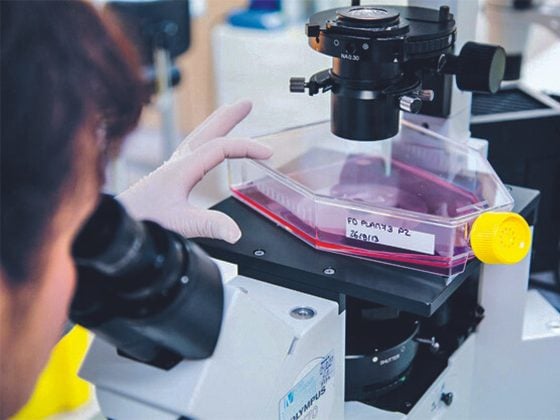
The Regenerative Medicine Revolution
The use of stem cells is part of a field called regenerative medicine, which began to emerge two decades ago as a way to deploy the body’s own cells and growth factors to repair tissues by restoring their lost function. Several such therapies and products are already approved by regulators and in use, including skin substitutes for treating burns, scaffold products for healing surgical incisions and cord blood-derived products for treating certain blood diseases and disorders.
But over the next decade, the expanded use of stem cells to treat even more injuries and conditions could lead to a medical revolution. As researchers report from stem-cell clinical trials being conducted all over the world, the hope that these cells can repair damaged bodies, long discussed and debated in scientific circles, appears to be well founded.
In a study treating congenital vision loss with retinal stem cells at the University of California, Irvine, for instance, one woman was able to see her family for the first time in years. A German child suffering from a sometimes-fatal skin disease called epidermolysis-bullosa recovered after receiving a transplant of genetically modified skin cells at Italy’s University of Modena and Reggio Emilia. The actor Selma Blair reported symptom remission last August after participating in a stem-cell transplant trial for multiple sclerosis. And a multi-centre study on treating osteoarthritis underway in Ireland, France and the Netherlands shows promising early results from 18 patients.
Despite these early successes, Shammaa cautions that the science is so new that it is easily misunderstood and misapplied. “There are a lot of snake-oil salesmen out there,” he says, pointing to private stem-cell clinics all over the world that claim to cure such things as erectile dysfunction and dementia, doing so without genuine evidence and in defiance of regulatory bodies. “It’s important for patients to learn what is possible right now and what is still down the road.”
He adds, “Some patients are good candidates for simple procedures like a bone marrow concentrate injection, but others have illness or injury that is too advanced or too complicated. We cannot give them false hope.”
That said, the field of stem-cell therapy is less than 20 years old and has already come a long way.

The Future of Stem Cell Therapy
An early breakthrough occurred in 2006, when Shinya Yamanaka, a molecular biologist at Kyoto University in Japan, showed that stem-cell therapy could avoid the morally divisive use of embryonic stem cells. Instead, he discovered he could induce adult skin cells to develop into blood or bone or liver cells. Yamanaka, who went on to win the 2012 Nobel Prize for this work, differentiated these cells from the kind found in a fertilized egg by calling them “induced pluripotent stem cells,” or iPSCs. While an embryo’s “totipotent” cells could turn into any part of the body, iPSCs could create many different kinds of tissues, but not a whole human. Since this discovery moved the conversation about stem cells past the sensitive subject of using fetal tissue for medical purposes, which is illegal in some countries, the research began to take off.
In 2014, Tokyo’s Riken research institute performed the first-ever successful iPSC transplant, creating retinal cells generated from skin cells from a patient with age-related macular degeneration. Shortly afterwards, Dr. Henry Klassen at the University of California, Irvine, oversaw a trial for treating retinitis pigmentosa, a rare genetic group of disorders causing gradual blindness, in which a donor’s retinal progenitor cells were transplanted into the eyes of 28 study participants. One of them, 64-year-old Kristin Macdonald of Los Angeles, who had gone blind, regained what she describes as a burst of light. “I can navigate by light now, and see more contrasts and shapes,” she says. Macdonald has since become an outspoken patient advocate for stem-cell trials.
Then, in 2018, neurosurgeon Richard Fessler of Rush University Medical Center in Chicago oversaw a year-long trial with iPSC stem cell-derived motor neurons transplanted into six patients paralyzed by spinal cord injuries. Fessler reported that all regained some upper-body movement, and that a patient who was only able to shrug his shoulders can now use his hands to eat, write and do other tasks. This is the kind of breakthrough that the late Superman actor Christopher Reeve was advocating for from his wheelchair, after neck-down paralysis from a horseback-riding accident, while governments around the world were making moves to restrict embryonic stem-cell research. (In certain cases, embryonic stem cells are in medical use, derived from leftover blastocysts—the clustering of cells in a fertilized egg—that didn’t implant during an IVF treatment.)
These are still early days, with much to investigate in terms of safety, dosing and how to manufacture iPSCs for different conditions in a standardized and cost-effective way. But Yamanaka predicted in 2018 that several treatments using regenerative medicine and new drugs will be developed, authorized and covered by insurance as soon as 2030.
“We’re looking at regenerative medicine as something that will one day be a medical specialty of its own,” adds Dr. Shane Shapiro, associate professor of orthopedic surgery at Mayo Clinic in Jacksonville, Florida, “much like cardiology or neurology.”
In the meantime, the first generation of stem-cell treatments that currently have regulatory approval in Canada, the U.S. and the European Union largely involve simple cell transplants—ones that move the patient’s own cells from one part of their body to another. That said, stem-cell transplants for blood diseases like leukemia have been used for several years, this being the one exception where a matching donor’s cells are also allowed.
Among approved procedures, the most common is BMAC transferred to the spine or the knee. While Jobb sought treatment for her back, 58-year-old telecommunications technician Rodolfo Corsini was looking for relief for job-related knee pain when he visited Italy’s Humanitis research hospital in 2020. He had never heard of BMAC until it was suggested to him by surgeon Elizaveta Kon, who didn’t see enough damage to merit knee replacement surgery. He agreed to the injection, and it was a success. “I can do almost everything that I did before,” he says.
Kon, along with some European colleagues, is now involved in a number of exploratory studies, including a comparison of treating patients with BMAC plus another type of adult stem cell—called stromal vascular fraction (SVF)—which is extracted from a person’s fat tissue.
Will it work? Certainly the early research on BMAC provides hope, although with limitations. “We couch these treatments as something to help with a chronic, degenerative condition, something that in many cases can be successful in managing the symptoms and improving quality of life but in most cases are not a cure,” Shapiro says. “The analogy should be diabetes or high cholesterol. We don’t cure those things; we treat them. What we would like to see in the future is a way to treat arthritis without metal and plastic, or to treat degenerative disc disease without a spinal fusion. That’s the ultimate goal.”
A consortium of 10 European partners, including universities, is in pursuit of that goal, and researchers are even looking to skip the painful marrow extraction procedure that Jobb underwent. Instead, says research scientist Mary Murphy at National University of Ireland, Galway, they hope to be able to create MSC cells in the laboratory in a standardized and high-volume way. And while some members of the EU-funded group are focusing on how to generate that sustainable supply, others are testing new therapies. For example, researchers in Sweden and the Netherlands are currently developing one for osteoarthritis. It will be several more years before everything can be tested, approved and made available.
Because regenerative medicine is still young, and patients should be wary of profit-hungry companies selling fraudulent stem-cell products, those who want to know their options should start by consulting with a medical expert on their specific condition. “If it’s knee arthritis, start with a specialist in orthopedic surgery or sports medicine,” advises Shapiro. “If it’s degenerative disc disease of the lumbar spine, start with a spine specialist.” Then, seek a referral to someone in that field who has learned about regenerative medicine.
For many patients, stem-cell therapy is already making a lasting difference to their quality of life. “My husband and I went hiking last summer,” Jobb says. “I walked a whole kilometre. I was so excited. I thought, maybe I could start cross-country skiing! Why not?”

Types of Stem Cells
Here are the main types of stem cells being used in the rapidly developing field of regenerative medicine.
By Tina Knezevic
Pluripotent
A few days after fertilization, an embryo becomes a mass of about 100 cells (a blastocyst) that can become any type of body cell. Since there are ethical concerns with harvesting them, scientists are learning to reprogram adult cells to act like pluripotent stem cells. These induced pluripotent stem cells (iPSCs) hold promise for diseases like macular degeneration, Parkinson’s and heart disease. (Don’t miss these tips on how to reverse heart disease.)
Multipotent
Multipotent stem cells can develop into more than one cell type but are more limited than pluripotent cells. For instance, mesenchymal stem cells are a type of multipotent cell that can come from bone marrow, fat tissue (from stromal vascular fractions), an umbilical cord or amniotic fluid. They’re popular in regenerative medicine, and there’s potential for them to treat many conditions, including spinal cord and cartilage injury, as well as rheumatoid arthritis.
Unipotent
Unipotent stem cells can become only one thing. There is research underway to see how skin stem cells could be used to regenerate skin after burns, which would normally be treated with skin grafts.
Next, put your knowledge of medical trivia to the test.
Hard-boiled eggs are handy to have around. They’re easy to make and great to stash in your fridge for a high-protein snack, quick breakfast or to slice into salads. Honestly, the hardest part of eating hard-boiled eggs is peeling them.
But what if we told you there was a TikTok hack for peeling hard boiled eggs? We’ve already turned to the video platform to learn how to properly clean the glass in your oven door, whisk like a pro and make your pots look brand new, so why not?
The Hack For Peeling Hard Boiled Eggs
The viral video by @sidneyraz shows him putting a hard boiled egg into a glass canning jar that’s half full of water. He screws on the lid, and vigorously shakes it around for 10 to 20 seconds. You can see that the shell is already starting to peel off, and he then uses both hands to easily peel off the rest of the shell.
@sidneyraz the frustration of peeling eggs realized #tipsandtricks #todayilearned #lifehacks #TikTokTaughtMe #cookinghacks #tiktokpartner ♬ original sound – sidneyraz
Does This Egg Peeling Hack Really Work?
The Kitchn tested a similar hack (this time performed in a mug instead of a canning jar) and found on the first attempt that if you shake your egg too hard in the mug it will damage the white a little. The sweet spot was letting the eggs rest for five minutes, then shaking the egg for just three seconds. It worked, but it didn’t necessarily take any less time than the standard methods. The consensus was that the shaking method—whether in a canning jar or a mug—was definitely more fun.
Next, find out how to store eggs the right way for optimal freshness.
Cold cuts, also known as lunch meat or deli meat, has a notoriously short shelf life—from savoury to slimy in a handful of days. Yet while most home cooks are comfortable freezing chicken breasts or stew meat, many still wonder: Can you freeze deli meat?
The short answer is absolutely yes. Deli meat can be frozen for up to two months as long as it’s prepared and wrapped properly to preserve the texture and moisture content. We’ll walk you through the steps here.
Which kinds of deli meat can you freeze?
All deli meat can be frozen. Cured meats, like sausage and bologna, tend to hold up the best, thanks to their dense, hearty texture and lower water content. Freezing roasted turkey, ham, chicken and other cold cuts is still possible, but the meat may be slightly wet upon defrosting. (Tips on that below!)
You can freeze deli meat in a large piece or in slices. For the best results, we suggest eating meat as soon as possible after freezing.
How to prepare deli meat for freezing
Pre-packaged meat is the simplest: if the package is unopened, just toss it directly into the freezer. Wrapping the package in an outer layer—like a plastic grocery bag or aluminum foil—will help reduce freezer burn.
Sliced meat from the butcher counter, or meat from an opened package, needs to be wrapped. Lay individual slices on pieces of wax paper or even paper towels, and freeze stacked in a plastic bag. Make sure to press the air out of the bag to preserve flavour and texture. When you’re ready to eat, you can remove as many or few servings as you need.
Large hunks of meat can simply be wrapped in plastic wrap; ideally, use a few layers and pop the bundle into a thicker freezer bag. Again, press as much air out of the wrapping as possible before freezing.
Make sure to label the wrapper with the contents and the frozen-on date!
How long can you freeze deli meat?
| Opened | Fridge | Freezer |
|---|---|---|
| Fresh meat | 3-5 days | 1-2 months |
| Packaged meat | 3-5 days | 1-2 months |
| Unopened | Fridge | Freezer |
| Fresh meat | 3-5 days | 1-2 months |
| Packaged meat | 2 weeks | 2 months |
| Cured meat | 2 months | 3 months |
You can store most deli meat in the freezer for up to two months. After that, the texture and flavour will probably deteriorate. Cured meats will still be tasty for up to three months.
How to defrost deli meat
The best way to defrost is to transfer the meat—the entire package or the portion you want to eat—into the refrigerator to thaw. If you’re in a hurry, place the wrapped meat in a bowl of cold water and change the water frequently.
Before using, pat the defrosted meat with a paper towel to remove any excess water. You can stash the meat in the fridge for about three to four days.
Pro tip: If the meat has shredded or lost some of its flavour, it’s not a lost cause! Try chopping it into a casserole, tossing into a vegetable skillet or topping a pizza. A bit of heat and other seasonings bring the meat back to life.
The bottom line is, if you find a great deal at the deli counter, or are storing leftovers from a family potluck, you can easily freeze deli meat. Next, find out the expiration dates you should never ignore.
Crunched for time? Here’s how to identify the fastest grocery store line
You’re in a hurry at the grocery store, and the lines are long: Do you queue up behind the person with a full cart or slide over to the line with four or five people holding baskets? According to Dan Meyer, a chief academic officer at the math site Desmos who has studied grocery lines, get behind the shopper with a full cart of goods.
“Every person requires a fixed amount of time to say hello, pay, say goodbye, and clear out of the lane,” Meyer recently explained to the New York Times. His research indicates that process takes about 41 seconds; it also takes about three seconds to ring up each item. An express line with four customers carrying baskets with around 10 items each will take about five minutes to clear. That guy with 60 items in his cart will get through the register in less than four minutes, according to Meyer’s findings.
Choosing a line with a clear line of sight to the cashier is another key to picking the correct line, reports the New York Times. If cashiers can’t see the end of the line, they are less motivated to work quickly as they have no visual cue as to how many people are actually waiting to be rung up.
Other ways to get through the grocery store line as quickly as possible include:
- Be on the lookout for either chatty cashiers or chatty customers. Those are not the lines to be on if you need to be somewhere in a hurry.
- As you set items on the belt, turn the barcode toward the cashier to make their job easier.
Next, check out the best apps to save money on groceries.

Back in 1937, my parents owned a small nursery in a village close to Lake Constance, near the border between Switzerland and Germany. Swiss people were well aware of, and concerned about, what was happening across the border in Germany, because Hitler and the Nazis were obviously on the rise. Around the same time, the Canadian government was advertising to the world that cheap land was available in Canada.
After the First World War, Canada settled many returning soldiers on vacant farmland. During the Depression, it did not take long before these new farmers, often with no actual farming experience, had to move to the cities to find work or face starvation. So, the Canadian government’s way of thinking seemed to be, why not settle a bunch of land-hungry people from Europe on all of this empty land?
You can hardly imagine the effect that seeing almost limitless land being made available at bargain prices had on European farmers trying to make a living off of a tiny half-acre plot. No wonder Canada, although far away, was so tempting for so many, my parents included.
On the Move
As a seven-year old, I was not privy to how our big move unfolded, but I assume everything was sold; clothing and other goods were packed; and tickets were bought. We were scheduled for departure in late August or early September 1938, but before that time arrived, history intervened. In early March of that year, Hitler annexed Austria and our plans were put on hold.
Then, in September 1938, in response to Hitler’s unwavering ambition to annex the Sudetenland, a region of western Czechoslovakia that was home to some 800,000 people, mainly German speakers, British Prime Minister Chamberlain went to Munich to meet with Hitler. Not wishing to provoke a war, Chamberlain chose the path of appeasement by signing the Munich Agreement, essentially enabling Hitler to have his way. With the rumblings of war silenced for a time, life returned to “business as usual.”
Being a youngster at the time, the historical events taking place around me did not fully capture my interest. There is one memory, however, that I can still see vividly in my mind’s eye: In mid-September 1938, the Graf Zeppelin was launched from Friedrichshafen, Germany, just across the lake from us. On its maiden flight, the huge airship travelled over our town accompanied by what seemed to this young boy’s eyes to be hundreds of Messerschmitt fighter planes.

Crossing the Atlantic
The end of that September saw us on our way to Le Havre, France, to board the SS Aurania, which would take us to Canada. Our small state room and the large dining hall are the first things that come to mind as I recall our time onboard.
I also remember that we sailed directly into a fierce North Sea storm. For two whole days, my brother Rene and I were the only people out and about in the dining room. The crew found us a safe place on deck to watch the storm. The ship was a mid-sized passenger vessel, yet the waves towered over it in the storm. As the boat started to climb upwards from the bottom of a trough, the stern of the ship would go completely under water. Likewise, when we crested a wave, the ship’s propellers would poke out above the water line, and the whole ship would shake, then the bow would dip deep under water as the ship reached the next trough. As kids, we thought this was all great fun!
As we neared Halifax, an iceberg was spotted and this conjured up fearful thoughts of the Titanic among the passengers. Thankfully, we sailed right past it without incident, ending our ocean voyage in Quebec City.
From there, we spent three days and nights on a train to Toronto. All we saw through the window was spruce forest, causing Mother to wonder what we had gotten ourselves into.
In Toronto we stayed on Bloor Street, near High Park. Dad spent most days tracking down farms for sale in the outlying regions. Mother informed him that the one and only thing she wanted included in any farm purchase was a good house, because many of the available farms had old houses in bad repair.

A New Home
On days when Dad was not out looking at farms, we would walk to High Park to enjoy some family time together. Mother was taken aback to see that the bridges in this wonderful parkland were nothing more than cut-down trees dropped over the creeks and hollows, smoothed over a little bit on the topside. Still, it was a magical experience for us in a brand new country! On the way home, we would stop at a local eatery called the White Grill for a hot chocolate—it was so good that I remember that hot chocolate to this very day. We had all our meals at the White Grill, too.
Eventually, Dad found a farm with a solid, two-storey brick house and a decent barn. There was no hydro or running water, however, and we had a Quebec heater for warmth.
Our new home was situated in Glanford Township, near Mount Hope and Caledonia. The day after we settled in, Dad took me to the local school. There were eight grade levels being taught in one room by a young teacher, who appeared to be just out of school herself. Having a kid dropped on her who spoke virtually no English must have been a shock for her! Having attended school for one year in Switzerland, where discipline was strict, I was surprised by the casual discipline in effect here. Not understanding a word, the only thing I could follow was math. I found it odd that many of the Grade 8 students had trouble with problems we solved in Grade 1 back in Switzerland.
You have to remember in those days there were no English as a Second Language programs, systematized health care or other services to help immigrants acclimatize to their new surroundings. Newcomers essentially swam on their own initiative or sank; nobody really noticed or cared what happened to immigrants all that much. In those days, immigrants were often regarded as “damn foreigners,” especially if you spoke a language that sounded like German. But my parents and, by extension, my brother Rene and I, were determined to build a new life here, and thankfully we were able to do so.
We all became Canadian citizens and the family has now been in Canada for decades. Both Rene and I put down solid roots and have made a good living here. We were also fortunate to marry and to raise wonderful families of our own, for whom Canada is their country of birth. Rene and I relished the freedom we had here when we first started out. In the old country, everything was controlled—you needed a license to do anything. Here in Canada, we were free to try different options—if one thing failed, you could pick yourself up and try your hand at something else.
I feel my brother and I have made a real contribution to our new homeland. I’m now in my late 80s, and I thank Canada for a great life.
Next, read the powerful story of how an act of kindness meant the world to one postwar immigrant family.
I must apologize to my mother for all the she-sounds-like-she-swallowed-a-peanut-type jokes I made as she dozed and snored on car trips. How was I to know that, many years later, I would be the one making great gargle and snort noises as the scenery flew by my passenger side window?
It happened, sneakily yet noisily. One time, after waking, my sleeping partner said I’d been snoring. I denied it at first; “I do not snore.” However, after repeated accusations, I finally had to face the non-melodious music: I was a snorer.
I soon became aware of the trumpeting elephant in the room that no one talks about and that I once participated in myself: snorism. It’s as though snoring is a shameful habit like picking your nose in public or owning a small dog that can’t be dissuaded from humping the legs of strangers. Which is why no one wants to admit they snore and why my mother may disown me upon hearing that I outed her.
Those whom the No-Snore Gods have smiled upon are quietly elitist. “You were snoring,” is usually said in an accusatory tone as, “You spit in my coffee.” Here is the difference, oh glorious and favoured Non-Snorers: If we spat in your coffee, it was because we meant to, generally when your backs were turned and you were making us feel badly about the noises we made in the night. Or in the car. Or on the couch. The nocturnal noises we make are a biological circumstance over which we are mostly powerless. I say mostly powerless because there are suggested remedies to alleviate our reverberations.
I once read that taping a tennis ball to the back of my pajamas to keep me from sleeping on my back would reduce snoring. Seriously? First, being intensely non-sporty means I have no tennis balls at hand. I suppose I could use a soup ladle but, second, I sleep in the buff and don’t relish the thought of ripping a duct-taped soup ladle off the skin of my back every morning.
There are recommendations for drinking different types of herbal tea before bed—but let me forewarn you, tea makes me pee. I might not snore, but I will be waking everyone up by stumbling out of the bed, cracking my shin on the dresser and swearing loudly four or five times a night on my way to bathroom. The next morning, I will be cranky, sleep-deprived and you’d best keep your eyes on your mug of coffee.
I read a list of possible solutions to my sleeping partner. “I could wear a whiplash neck brace and chew raw garlic before bed. It’s a good thing I’m not single,” I said.
He eyed me dubiously. “You still could be.”
What would you prefer? A snorer or a neck-braced, soup-ladle-taped, garlic-reeking, oft-peeing partner? I know what I would choose, but, then again, I can’t hear myself.
Next, check out this roundup of silly sleep jokes.
Boost Your Eye Health With Blueberries
Mix a cup of blueberries with a cup of yogurt for breakfast in the morning. Blueberries are one of the richest fruit forms of antioxidants, and a study published in The Archives of Ophthalmology found that women and men who ate the greatest amount of fruit were the least likely to develop age-related macular degeneration (ARMD), the leading cause of blindness in older people.
Sneak in Spinach
Have spinach twice a week. Could be a spinach quiche, steamed spinach, or maybe Tuscan spinach-sautéed in some olive oil with garlic and raisins. Regardless, be sure to get your spinach. Studies find that lutein, a nutrient that is particularly abundant in spinach, may prevent ARMD and cataracts. Ideally, get your lutein in combination with some form of fat (olive oil works great) for the best absorption.
Take Car Precautions
Aim your car vents at your feet—not your eyes. Dry, air-conditioned air will suck the moisture out of eyes like a sponge. Aim the vents in your car away from your eyes, or wear sunglasses as a shield. Dry eyes can be more than an inconvenience; serious dryness can lead to corneal abrasions and even blindness if left untreated.
Monitor Your Monitor
Move your computer screen to just below eye level. Your eyes will close slightly when you’re staring at the computer, minimizing fluid evaporation and the risk of dry eye syndrome, says John Sheppard, M.D., who directs the ophthalmology residency program at Eastern Virginia Medical School in Norfolk, Virginia.
Feast on Fish
Eat fish twice a week. A study from Harvard evaluated the diets of 32,470 women and found those who ate the least amount of fish (thus getting the least amount of omega-3 fatty acids) had the highest risk of dry eye syndrome. (This is the healthiest fish you can eat.)
Be Cool
Turn down the heat in your house. Heat dries out the air, which, in turn, dries out your eyes. In the winter, you might also try adding some humidity with a humidifier or even bunching a lot of plants together in the room in which you spend the most time.
Hide Behind Shades
Wear sunglasses whenever you leave the house. When researchers examined the relationship between exposure to sunlight and cataracts or ARMD in Chesapeake Bay fishermen, they found that fishermen who protected their eyes from the harsh glare of the sun and its damaging UV rays were significantly less likely to develop these conditions than those who went bare-eyed. Wear the sunglasses even when it’s not sunny out, says Dr. Sheppard. They protect your eyes from the drying effects of wind.
Don a Broad-Brimmed Hat
Wear a broad-brimmed hat along with your sunglasses. A wide-brimmed hat or cap will block roughly 50 per cent of the UV radiation and reduce the UV radiation that may enter your eyes from above or around glasses.
Binge on Beets
Roast some fresh beets for an eye-saving side dish. Beets get their deep red colour from phytochemicals called anthocyanins, powerful antioxidants that protect the smaller blood vessels in your body, including those in your eyes. (Find out more surprising health benefits of beets.)
Give Yourself the Spa Treatment
Dab an essential oil of jasmine, peppermint, or vanilla on your arm and sniff. Jasmine, says scent researcher Alan R. Hirsch, M.D., of the Chicago-based Smell and Taste Treatment Research Foundation, increases the beta waves in the frontal lobes of your brain, promoting wakefulness and enabling you to focus better and see things more acutely. All three scents stimulate the limbic system in your brain, which, in turn, stimulates the rods in your eyes, which help you see in dim light.
Now that you know how to improve your eyesight, learn how to spot the telltale signs of cataracts.
Silica gel packets aren’t really a nuisance, like the layers of tape, bubble wrap and air-filled insulation pouches you have to fight through to open packages. Instead, silica gel packets are just there, omnipresent in everything from blenders to shoeboxes to winter coat pockets. But what exactly is the purpose of silica gel packets—and, given those dire warnings of “do not eat” stamped across them, just how dangerous are these things?
The reason why they’re so crucial is because they’re a cheap and effective desiccant, an agent which is used to suck water vapour out of the air and keep an environment dry. For leather products, a dry environment is crucial for staving off mold and preventing shrinkage. The reasoning is similar when it comes to food, as a damp environment is prime for bacteria development and accelerated spoilage. Electronics and water don’t mix well, either. In fact, the silica in kitty litter is the prime reason why you can use it to defog your car windows, too.
Although the packets explicitly say “do not eat” on them, Silica, or silicon dioxide, it’s relatively harmless which is why it’s fine to store in food packaging. Slate noted that, sure, you could eat the packet if you wanted to. The stuff can absorb 40 per cent of its weight in moisture, but consumption is just going to drain your fluids, so you probably just shouldn’t eat it at all.
Now that you know what silica gel packets are for, find out the reason suit pockets come sewn shut.
[Source: How Stuff Works]

How to Pour Oil the RIGHT Way
Ever notice how motor oil bottles have an “off-centre” spout? It’s designed that way to cut down on spills. Most people think the spout should be on the bottom side of the bottle as you pour. That’s wrong. Because after just a few seconds in that position, the bottle will start to “burp” and spurt oil. To eliminate the “glug, glug, spurt, spurt,” pour with the spout in the “up” position. Yes, that makes it harder to aim, but once you get going, you’ll have a smooth stream without any “glugging.”
Now that you know how to pour oil the right way, find out exactly how often you should be changing your oil.

